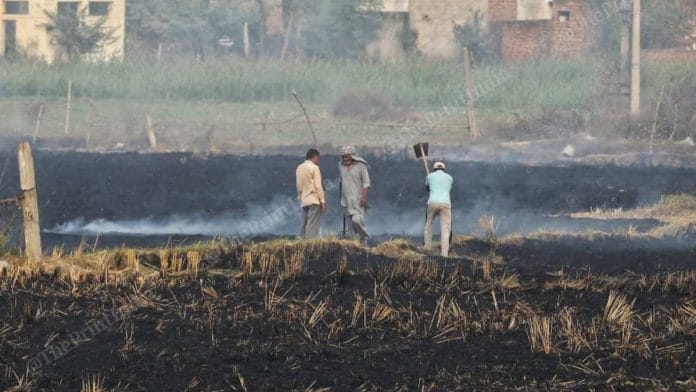New Delhi: It is that time of the year again when acres of paddy fields in Punjab and Haryana are set ablaze for the next crop season, bringing plumes of thick, grey smoke into the national capital. And this year is unlikely to be any different.
Satellite data from the National Aeronautics and Space Administration (NASA) shows that northwest India is predicted to record 15,500-18,500 stubble fire cases this season unless strict on-ground monitoring is conducted.
Hiren Jethva, senior aerosol remote sensing scientist with the NASA Goddard Space Flight Centre, analysed the area of paddy sown in the agrarian states of Punjab and Haryana using NASA’s Moderate Resolution Imaging Spectroradiometer (MODIS) Aqua satellite, which is a 36-band spectroradiometer designed to measure the physical properties of the atmosphere and the biological and physical properties of the oceans and land with a detection power up to 1 km.
“Post-monsoon seasonal fire prediction (October and November) for 2024 over northwest India has arrived. Aqua MODIS NDVI (normalised difference vegetation index) data suggests nearly 15,500-18,500 fire occurrences (1-km detection) strictly under ‘as usual burning’ practice (2002-2016)—comparable to 2020 but lower than in 2016 and 2021,” Jethva said.
He, however, added that on-ground action by government agencies to reduce stubble fires could reduce the numbers significantly. This was proven by the numbers in 2023.
“Actual fire counts in 2023 were lower by 40 percent than predicted, indicating some serious ground efforts to reduce burning activities. Hoping for even more momentum this year,” he said.
Also read: Water demand is rising fast. Few realise how it impacts the climate crisis
Declining trend
Every year, by September end, farmers in agrarian states, including Punjab, Haryana, and Uttar Pradesh, start setting their fields on fire to get rid of paddy stubble left behind after harvest. Despite concerted efforts by the central and state governments to provide mechanised alternatives, farmers burn stubble as an easy and cheap option.
The smoke from this large-scale burning, however, is carried to Delhi and neighbouring states with the winter winds, worsening the already poor air quality of the region.
According to the Union Environment Ministry data, stubble fires in Punjab and Haryana have been on a decline. Government data shows that between 5 September and 30 November, Punjab recorded 36,663 stubble fires in 2023, as opposed to 49,922 in 2022, 71,304 in 2021, and 83,002 in 2020.
In Haryana, only 2,303 stubble fires were reported in 2023. In 2022, the state registered 3,661; in 2021, 6,987; and in 2020, the fire count in Haryana was 4,202.
“Punjab recorded an overall 27 percent decrease in the total fire counts owing to paddy stubble burning during 2023 as compared to 2022. The percent reduction in the farm fires in 2023 with respect to the figures in 2021 and 2020 has been 49 percent and 56 percent, respectively,” a 2023 statement released by the Ministry of Environment, Forest and Climate Change (MoEFCC) read.
It added, “A substantial reduction has also been witnessed in the total number of paddy farm fires in Haryana, i.e. 37 percent reduction in 2023 vis-à-vis 2022. The reduction in farm fire incidences in 2023 with respect to 2021 has been much higher at 67 percent, while a reduction of 45 percent has been witnessed compared to the incidences in 2020.”
Early numbers
Experts monitoring trends say stubble burning has already begun in Punjab and Haryana, with nearly 127 fires reported between 19 and 24 September.
“The early paddy varieties are being harvested. By mid-October, the numbers will likely go up further,” said Ravindra Khaiwal, professor at the Department of Community Medicine and School of Public Health, in Chandigarh’s Postgraduate Institute of Medical Education and Research (PGIMER).
Every year, along with Punjab and Haryana, crop residue burning from Pakistan also adds to India’s pollution load.
During winters, north-westerly winds blowing from these farmlands end up in Delhi, increasing the pollution load. The frigid season does not allow these pollution particles to disperse at a regular rate, leading to the annual deterioration of air quality.
Anumita Roychowdhury, executive director (research and advocacy) at the Centre for Science and Environment (CSE), said that finding a solution to this annual problem would require intervention on multiple levels.
“The authorities have to conduct strict monitoring on-ground. But this is not a long-term solution. Machines for mulching straw need to be made available to farmers, provide financial incentives, and have a functional alternative for straw management,” Roychowdhury said.
(Edited by Zinnia Ray Chaudhuri)






